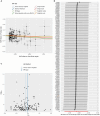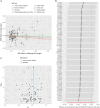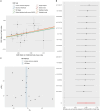Mendelian randomization shows causal effects of birth weight and childhood body mass index on the risk of frailty
- PMID: 38855449
- PMCID: PMC11158621
- DOI: 10.3389/fpubh.2024.1270698
Mendelian randomization shows causal effects of birth weight and childhood body mass index on the risk of frailty
Abstract
Background: The association between birth weight and childhood body mass index (BMI) and frailty has been extensively studied, but it is currently unclear whether this relationship is causal.
Methods: We utilized a two-sample Mendelian randomization (MR) methodology to investigate the causal effects of birth weight and childhood BMI on the risk of frailty. Instrumental variables (p < 5E-08) strongly associated with own birth weight (N = 298,142 infants), offspring birth weight (N = 210,267 mothers), and childhood BMI (N = 39,620) were identified from large-scale genomic data from genome-wide association studies (GWAS). The frailty status was assessed using the frailty index, which was derived from comprehensive geriatric assessments of older adults within the UK Biobank and the TwinGene database (N = 175,226).
Results: Genetically predicted one standard deviation (SD) increase in own birth weight, but not offspring birth weight (maternal-specific), was linked to a decreased frailty index (β per SD increase = -0.068, 95%CI = -0.106 to -0.030, p = 3.92E-04). Conversely, genetically predicted one SD increase in childhood BMI was associated with an elevated frailty index (β per SD increase = 0.080, 95%CI = 0.046 to 0.114, p = 3.43E-06) with good statistical power (99.8%). The findings remained consistent across sensitivity analyses and showed no horizontal pleiotropy (p > 0.05).
Conclusion: This MR study provides evidence supporting a causal relationship between lower birth weight, higher childhood BMI, and an increased risk of frailty.
Keywords: Mendelian randomization; birth weight; body mass index; childhood; frailty.
Copyright © 2024 Cui, Fu, Zhu, Li and Song.
Conflict of interest statement
The authors declare that the research was conducted in the absence of any commercial or financial relationships that could be construed as a potential conflict of interest.
Figures




Similar articles
-
Obesity, birth weight, and lifestyle factors for frailty: a Mendelian randomization study.Aging (Albany NY). 2023 Dec 12;15(23):14066-14085. doi: 10.18632/aging.205290. Epub 2023 Dec 12. Aging (Albany NY). 2023. PMID: 38095641 Free PMC article.
-
Causal relationships between birth weight, childhood obesity and age at menarche: A two-sample Mendelian randomization analysis.Clin Endocrinol (Oxf). 2023 Feb;98(2):212-220. doi: 10.1111/cen.14831. Epub 2022 Oct 25. Clin Endocrinol (Oxf). 2023. PMID: 36237121
-
Assessment of bidirectional relationships between frailty and acute respiratory distress syndrome: a bidirectional Mendelian Randomization study.BMC Geriatr. 2024 Nov 29;24(1):981. doi: 10.1186/s12877-024-05579-w. BMC Geriatr. 2024. PMID: 39614164 Free PMC article.
-
Association of maternal circulating 25(OH)D and calcium with birth weight: A mendelian randomisation analysis.PLoS Med. 2019 Jun 18;16(6):e1002828. doi: 10.1371/journal.pmed.1002828. eCollection 2019 Jun. PLoS Med. 2019. PMID: 31211782 Free PMC article. Clinical Trial.
-
Childhood, adolescent, and adulthood adiposity are associated with risk of PCOS: a Mendelian randomization study with meta-analysis.Hum Reprod. 2023 Jun 1;38(6):1168-1182. doi: 10.1093/humrep/dead053. Hum Reprod. 2023. PMID: 37015099 Free PMC article.
Cited by
-
Association between oral health status and frailty in older adults: a systematic review and meta-analysis.Front Public Health. 2025 Mar 31;13:1514623. doi: 10.3389/fpubh.2025.1514623. eCollection 2025. Front Public Health. 2025. PMID: 40231179 Free PMC article.
References
MeSH terms
LinkOut - more resources
Full Text Sources
Medical

